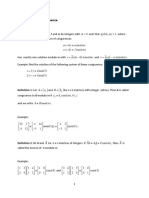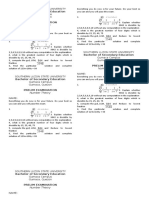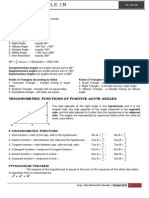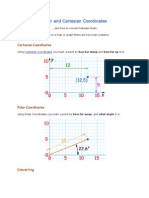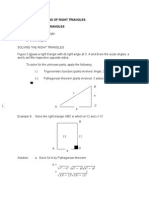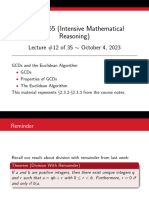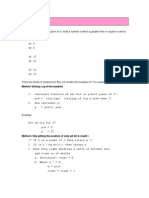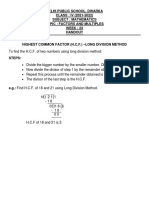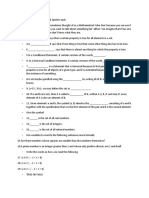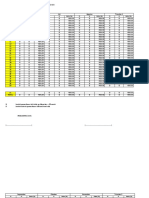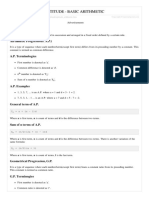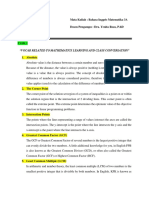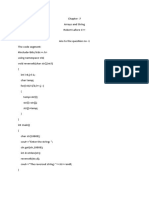Notes For Abstract Algebra
Notes For Abstract Algebra
Uploaded by
Sankalp ChauhanCopyright:
Available Formats
Notes For Abstract Algebra
Notes For Abstract Algebra
Uploaded by
Sankalp ChauhanOriginal Description:
Original Title
Copyright
Available Formats
Share this document
Did you find this document useful?
Is this content inappropriate?
Copyright:
Available Formats
Notes For Abstract Algebra
Notes For Abstract Algebra
Uploaded by
Sankalp ChauhanCopyright:
Available Formats
Sonny Chauhan
RPI
Abstract Algebra notes (week 1):
Well ordering Principle:
Every nonempty set of positive integers contains a smallest number, member.
Divisor:
is when a number is divisible by another number. When we divide the numbers we get remainder 0. For
example a nonzero integer t is a divisor of the integer s if t is divisible by s. That means there exists an
integer u such that s=tu. We write t|s also known as (“t divides s”).
Division Algorithm:
Let b>0 and a and b be integers. There has to exist integers q and r where r is greater than or equal to 0
and less than b such that a=bq+r. In this case a is the dividend, b is the divisor, q is the quotient and R is
the remainder.
For example: 345/8= 43 remainder 1. Thus by the division algorithm I get 345= 8 * 43 + 1.
In order to write x is not divisible by y, I write: x y ( also known as x does not divide y)
If x is divisible by y, I write: x | y.
An integer is prime if it is greater than 1 and its only divisors are 1 and itself.
Example: 13 is prime since its only divisors are 13 and 1.
The only even number that is prime is 2.
Two numbers are relatively prime if the gcd of them equals 1. For example a and b are relatively prime if
gcd(a,b) = 1.
The greatest common divisor (gcd) or greatest common factor (gcf) of two numbers like a and b, is the
greatest number that is divisible by both a and b.
Let a and b as integers, then the gcd(a,b) can be written as as+bt. Moreover gcd(a,b) is the smallest
positive integer of the form as+bt.
For example: Find integers s and t such that gcd(662,414)= 662s+414t.
By the Euclidean algorithm, I can find the gcd of 662 and 414. First I divide 662 by 414 and I get 1
remainder 248.
Thus: 662 = 414(1) + 248
Then I divide the other number by the remainder. In this case I divide 414 by 248 and get 1 remainder
166
414 = 248(1) + 166
And the process continues, I divide 248 by 166 to get:
248 = 166(1) + 82
I divide 166 by 82 to get:
166 = 82(2) + 2
I divide 82 by 2 to get:
82 = 2(41) + 0
When we get remainder of 0 our gcd is the second to last remainder before the 0 in this case 2. Thus
gcd(662,414) = 2.
In order to get the values of s and t, I have to work backwards,
I get:
2 = 166 – 82(2)
82 = 248- 166(1)
166 = 414 – 248(1)
248 = 662- 414(1)
Thus:
2 = (166-82(2))= (166- (248-166)(2)) = (166-2(248-166)) = (3(166) -2(248)) = (3(414-248(1))-2(248)) =
3(414) -3(248)-2(248)= 3(414)-2(248) = 3(414) -2(662-414(1)) = 3(414) + 2(414) -2(662) = 5(414) -2(662)
Thus s=-2 and t=5.
You might also like
- Sum and Differences IdentitiesDocument2 pagesSum and Differences IdentitiesAlonnah Marie RoblesNo ratings yet
- System of Linear Congruence: M M Ad BCDocument5 pagesSystem of Linear Congruence: M M Ad BCMimosaNo ratings yet
- Trigonometry WorkbookDocument20 pagesTrigonometry WorkbookElaine zhuNo ratings yet
- Unit 1: Measures of Central Tendency: Module 6: Descriptive Statistical MeasuresDocument10 pagesUnit 1: Measures of Central Tendency: Module 6: Descriptive Statistical MeasuresABAGAEL CACHONo ratings yet
- Matrices PDFDocument29 pagesMatrices PDFSudheer KothamasuNo ratings yet
- Parametric Equations and Polar CoordinatesDocument112 pagesParametric Equations and Polar CoordinatesZazliana IzattiNo ratings yet
- Chinese Remainder TheoremDocument7 pagesChinese Remainder TheoremManohar NVNo ratings yet
- 33 Simplified Radical FormDocument11 pages33 Simplified Radical FormJepot PascualNo ratings yet
- TRIG FUNCTIONS Lesson Solving Right TrianglesDocument52 pagesTRIG FUNCTIONS Lesson Solving Right TrianglesRudi BerlianNo ratings yet
- Matrix PYQDocument4 pagesMatrix PYQJalilah RubaiNo ratings yet
- Lesson 3. Division and Multiplication of Rational Expressions 1Document5 pagesLesson 3. Division and Multiplication of Rational Expressions 1Cristine Castulo PreguntaNo ratings yet
- 5 Linear Transformation of MatricesDocument53 pages5 Linear Transformation of Matricesalienxx100% (1)
- Linear Algebra AssignmentDocument11 pagesLinear Algebra AssignmentLim Yan HongNo ratings yet
- 2.3 Relation and FunctionDocument41 pages2.3 Relation and FunctionAlma G. FloridaNo ratings yet
- Module 1-What Is TrigonometryDocument10 pagesModule 1-What Is TrigonometryMark Paulo GonzalesNo ratings yet
- L6-L7-Matrices For Linear TransformationsDocument32 pagesL6-L7-Matrices For Linear TransformationsHarshini MNo ratings yet
- Real Number SystemDocument32 pagesReal Number SystemJoy MendozaNo ratings yet
- Mean Median Mode Grouped Data.Document21 pagesMean Median Mode Grouped Data.John Carl YomeroNo ratings yet
- Chapter 6 Binomial CoefficientsDocument21 pagesChapter 6 Binomial CoefficientsArash RastiNo ratings yet
- Mathematical Induction PDFDocument6 pagesMathematical Induction PDFGAEA FAYE MORTERANo ratings yet
- Trig Exam 2 Review F07Document6 pagesTrig Exam 2 Review F07Rodion Romanovich RaskolnikovNo ratings yet
- Problem Solving Mathematics - Lesson 1Document27 pagesProblem Solving Mathematics - Lesson 1Nishinoya KenNo ratings yet
- Module Requirement For Abstract AlgebraDocument6 pagesModule Requirement For Abstract AlgebraNimrod CabreraNo ratings yet
- Exponential and Logarithmic FunctionsDocument25 pagesExponential and Logarithmic FunctionsMukiNo ratings yet
- Worksheet On Angles and Radian MeasureDocument4 pagesWorksheet On Angles and Radian MeasureJose Emmanuel Sarumay ManingasNo ratings yet
- Euler and Chienese Remainder TheoremDocument36 pagesEuler and Chienese Remainder Theoremmidih11043No ratings yet
- Advanced Algebra MODULE Week 1-2Document247 pagesAdvanced Algebra MODULE Week 1-2Jun Dl CrzNo ratings yet
- Elimination Matching ActivityDocument2 pagesElimination Matching ActivityVictoria SchererNo ratings yet
- Number Theory: Bachelor of Secondary EducationDocument1 pageNumber Theory: Bachelor of Secondary EducationRea Mariz JordanNo ratings yet
- Vectors, Linear Combinations and Linear IndependenceDocument13 pagesVectors, Linear Combinations and Linear Independenceray hajjarNo ratings yet
- Algebraic ExpressionsDocument24 pagesAlgebraic Expressionsmanahilnasir67No ratings yet
- Practice Test On MatricesDocument10 pagesPractice Test On MatricesowaisNo ratings yet
- Review in TrigoDocument5 pagesReview in TrigoJohnMichaelM.ManaloNo ratings yet
- Mathm109-Calculus II - Module 3Document20 pagesMathm109-Calculus II - Module 3richard galagNo ratings yet
- Math 131 - Action Research in Mathematics EducationDocument9 pagesMath 131 - Action Research in Mathematics EducationAngel Guillermo Jr.No ratings yet
- 3.3 Function NotationDocument13 pages3.3 Function NotationEzekiel ArenzNo ratings yet
- 10 - 1 Simplifying Rational Expressions Trout 09Document14 pages10 - 1 Simplifying Rational Expressions Trout 09Vehid KurtićNo ratings yet
- WINSEM2020-21 MAT1014 TH VL2020210505929 Reference Material I 08-Apr-2021 1-Group Homomorphism Isomorphism and Related ExamplesDocument27 pagesWINSEM2020-21 MAT1014 TH VL2020210505929 Reference Material I 08-Apr-2021 1-Group Homomorphism Isomorphism and Related ExamplesMoulik AroraNo ratings yet
- Exercise Set 1.1: Concept ReviewDocument7 pagesExercise Set 1.1: Concept Reviewwarda rashidNo ratings yet
- Z0185001022015402412-13 Eigenvalues and EigenvectorsDocument30 pagesZ0185001022015402412-13 Eigenvalues and EigenvectorsYeni NuraeniNo ratings yet
- Regression Correlation ActivityDocument2 pagesRegression Correlation ActivityXiaoyu KensameNo ratings yet
- Chapter 3: DeterminantsDocument12 pagesChapter 3: DeterminantsMas GundNo ratings yet
- Inverse Trig Worksheet 1. Find The EXACT Value of The FollowingDocument3 pagesInverse Trig Worksheet 1. Find The EXACT Value of The FollowingDane AgoyaoyNo ratings yet
- Depedpang 1Document127 pagesDepedpang 1Bayoyong NhsNo ratings yet
- Unit 4 DM MathsDocument59 pagesUnit 4 DM Mathsxitekol233No ratings yet
- College AlgebraDocument30 pagesCollege AlgebraGelvie LagosNo ratings yet
- The Elimination Method Guided NotesDocument3 pagesThe Elimination Method Guided Notesapi-450522734100% (1)
- Matrix MultiplicationDocument26 pagesMatrix MultiplicationRodel D DosanoNo ratings yet
- Prob Quiz IDocument9 pagesProb Quiz IhareshtankNo ratings yet
- Simplifying and Evaluating Algebraic Expressions: Looking BackDocument27 pagesSimplifying and Evaluating Algebraic Expressions: Looking BackthebtcircleNo ratings yet
- 8.1 Worksheet Polar CoordinatesDocument3 pages8.1 Worksheet Polar CoordinatesRonnieMaeMaullionNo ratings yet
- Cartesian Coordinates To Polar Coordinates ConversionDocument13 pagesCartesian Coordinates To Polar Coordinates ConversionAmira Okasha100% (1)
- Lesson 3.0 Solutions of Right Triangles 3.1 Solving Right TrianglesDocument25 pagesLesson 3.0 Solutions of Right Triangles 3.1 Solving Right TrianglesJo HarNo ratings yet
- Solve Right Triangles PowerPointDocument13 pagesSolve Right Triangles PowerPointKatherine LeeNo ratings yet
- Math-1105 Fundamental of MathematicsDocument58 pagesMath-1105 Fundamental of MathematicsPubg StreamNo ratings yet
- Real Numbers Class 10 Maths Multiple Choice Questions With AnswersDocument93 pagesReal Numbers Class 10 Maths Multiple Choice Questions With AnswersMoolam RaoNo ratings yet
- 04-Number Theory and CryptographyDocument38 pages04-Number Theory and Cryptographynasrullah.syedNo ratings yet
- Number Theory Revision NotesDocument9 pagesNumber Theory Revision NotesSidharth AnchaliaNo ratings yet
- 1365 Lecture 12 Gcds and EuclidDocument64 pages1365 Lecture 12 Gcds and EuclidTahmid KhanNo ratings yet
- Discrete Mathematics: Theory of NumbersDocument38 pagesDiscrete Mathematics: Theory of NumbersOm SharmaNo ratings yet
- Chapter 5 Module IndicesDocument38 pagesChapter 5 Module IndicesCorey LopezNo ratings yet
- Darab 3 Digit Guna GridDocument20 pagesDarab 3 Digit Guna GridyasirmoktarNo ratings yet
- Byjus Test 2 CH 1 MCQDocument6 pagesByjus Test 2 CH 1 MCQdeepaksharma1976No ratings yet
- C Program BasicsDocument101 pagesC Program Basicspraisykattupalli5111No ratings yet
- 4 PriorityrulesDocument40 pages4 PriorityrulesOnumbah GodfirstNo ratings yet
- Bit MagicDocument43 pagesBit MagicAtul Pratap SinghNo ratings yet
- HXC2019 Trial P1Document11 pagesHXC2019 Trial P1stoneyNo ratings yet
- Six PharasesDocument110 pagesSix PharasesSanivika SanNo ratings yet
- Mathematics 7: Quarter 1 - Module 4Document10 pagesMathematics 7: Quarter 1 - Module 4Hayehaye MagdayaoNo ratings yet
- 4 MathsDocument3 pages4 MathsAvinash PatelNo ratings yet
- Class 4 Week 23 Mathematics AssignmentDocument6 pagesClass 4 Week 23 Mathematics AssignmentAbhigyan Mohan AgarwalNo ratings yet
- Math PDocument2 pagesMath PAldee Joy AlvarezNo ratings yet
- Remedial MathDocument3 pagesRemedial Mathnylxyxzy0411 albNo ratings yet
- Average Class NotesDocument31 pagesAverage Class Notesskaiyub74No ratings yet
- Further Mathematics NoteDocument24 pagesFurther Mathematics NoteAdeolaNo ratings yet
- WAKTU LAPOR NILAI KRITIS SatitiDocument10 pagesWAKTU LAPOR NILAI KRITIS Satitiluweny octaNo ratings yet
- Aptitude - Basic ArithmeticDocument2 pagesAptitude - Basic ArithmeticharieswaranNo ratings yet
- UPSC CSAT FormulaDocument25 pagesUPSC CSAT FormulaPaokhongam KipgenNo ratings yet
- Errors and Flow Chart NotesDocument32 pagesErrors and Flow Chart NotesKylie JennirNo ratings yet
- (PPT) Introduction To The Python Programming LanguageDocument36 pages(PPT) Introduction To The Python Programming LanguagecreatethreadNo ratings yet
- Business CalculationsDocument5 pagesBusiness Calculationsomondicliffton01No ratings yet
- Lesson 14 Grade 5 Module 1Document6 pagesLesson 14 Grade 5 Module 1api-333586079No ratings yet
- Chapter 2 Lesson 3 Math 8Document10 pagesChapter 2 Lesson 3 Math 8Jhon PayatNo ratings yet
- Grade 9 Mathematics SyllabusDocument64 pagesGrade 9 Mathematics SyllabusmshaymutakayaNo ratings yet
- Substraction Set 23Document3 pagesSubstraction Set 23Teacher WulanNo ratings yet
- 2.3 Derivatives of Exponential and Logarithmic FunctionsDocument7 pages2.3 Derivatives of Exponential and Logarithmic Functionsexplorers.beamaepetracortaNo ratings yet
- Rizki Zunianto - 2005111038 - Tugas 7 Bim 3aDocument6 pagesRizki Zunianto - 2005111038 - Tugas 7 Bim 3aRizki Zunianto 2005111038No ratings yet
- (STM) Verifying Trigo IdentitiesDocument8 pages(STM) Verifying Trigo IdentitiesRachel TatelNo ratings yet
- Robert Lafore, Chapter-7, Arrays and StringDocument23 pagesRobert Lafore, Chapter-7, Arrays and StringAsma Ul Husna OisheeNo ratings yet

